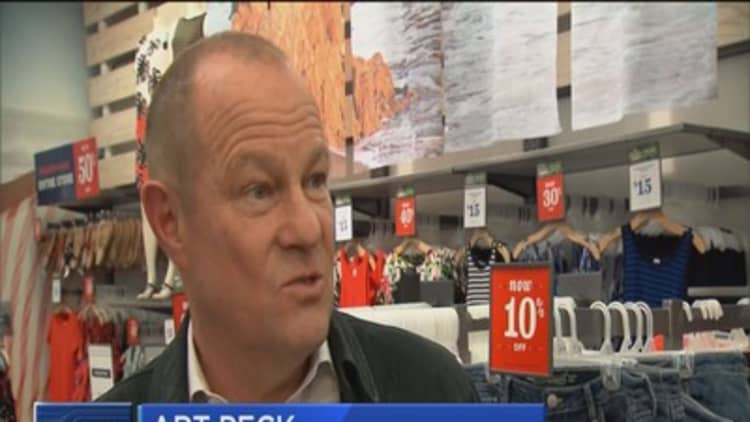Both stores appeal to sporting enthusiasts and fitness buffs as well as those who simply want to look the part. Each shop stocks popular athletic brands including Under Armour, Nike and The North Face.
Where they diverge, however, is their sales trajectories.
The year before Sports Authority was taken private by Leonard Green & Partners in 2006, it was pulling in annual revenue of about $2.5 billion. That figure was roughly in line with competitor Dick's Sporting Goods, which in 2005 posted sales of $2.6 billion.
Fast forward nearly 10 years, however, and Sports Authority's revenue has barely ticked higher, coming in at around $2.7 billion in 2014, according to Moody's. Dick's, on the other hand, raked in $6.8 billion last year, more than doubling its revenue over the same time frame.
Now, with two years under the belt for much of its executive team, Sports Authority is hoping to end years of what Moody's described as "inconsistent" operating performance—the result of weak execution, high promotional activity and competitive pressure.
Moody's recently upgraded Sports Authority's ratings outlook from "negative" to "stable," as the retailer works to tweak its merchandise mix, revamp its physical and digital stores, and cut costs. The credit rating agency added that Sports Authority should continue to improve its operations and control costs moving forward, which will help it maintain "adequate" liquidity over the next year.
Read MoreNike, Dick's get real in new round of women's ads
"They're implementing strategies to improve the operation," Moody's analyst Michael Zuccaro said. "That takes time to develop."
Sales of athletic apparel and shoes have been a bright spot in an otherwise challenged retail environment. The category's popularity, however, has brought with it an influx of competition. In addition to the growth of specialty stores such as Lululemon and Athleta, a slew of high-fashion brands have expanded into the sport category, including a line from Tory Burch coming this fall. Celebrities are also getting in on the trend, including Carrie Underwood's Calia line, sold exclusively at Dick's.
To help differentiate its merchandise—and offer products at an affordable price—Sports Authority over the past two years has "really put the pedal down" on private label brands, said Stephen Binkley, the retailer's executive vice president and chief merchandising officer. That includes the May launch of an exclusive apparel line with Champion, and last year, the introduction of a private label yoga brand called Bloom.
Though the private retailer would not disclose numbers on the sales or penetration of its private label goods, "We do see that as a major growth vehicle for us," Binkley said.

The company is also increasing its stake in the plus-size business, a category that is often ignored by major retailers and designers. Earlier this year it introduced plus-size apparel in its Aspire and Alpine Design lines, which span yoga and outdoor apparel. It will also expand its plus-size offerings in the back half of the year and 2016, as it pertains to Champion, Binkley said.
To show off the changes it's made to its merchandise—which Moody's said includes a shift toward more soft goods including apparel and footwear—Sports Authority is also in the process of revamping its store fleet.
These new locations give shoppers a more "intuitive" layout with dedicated specialty shops for categories such as yoga or golf. It also gives the retailer an opportunity to showcase some of its most popular brands, including Nike and Under Armour. Sports Authority first introduced the new format in 2011, and will continue to use the design in its new stores and remodels "that make sense," Binkley said.
Read MoreBra stuffing lifting trends at Lululemon
As many retailers across the U.S. shrink their footprints, Sports Authority's store count has remained relatively steady. It currently operates about 460 stores, down from about 475 in June 2013. That compares to roughly 400 stores when it was acquired back in 2006.
Though Moody's Zuccaro could not disclose the nature of or amount of savings that Sports Authority has incurred, he listed these pared down costs and improvements to its website as two positives.
"While the company remains susceptible to high competition, its nationwide footprint, product diversification in hard lines, apparel and footwear, and ability to leverage its vendor relationships help support the rating," Zuccaro wrote at the time of his outlook change.
Many of the company's strategic shifts stem from changes to its management team. These include former Petco Chief Financial Officer Michael Foss taking over as CEO in June 2013, followed by Binkley's appointment as chief merchandising officer one month later.
Despite the traction this team has gained, the company still faces challenges. Although Zuccaro said Sports Authority is making the necessary changes to its assortment, which skews toward apparel products that "a lot of people are focusing on," it's a category that's much more susceptible to the ebb and flow of trends.
"It's a fashion risk," he said.
Also hurting the overall sporting goods industry is weakness in the golf and hunting categories, areas where both Sports Authority and competitor Dick's have exposure. In a note to investors following its most recent earnings report, Stifel Nicolaus analyst David Schick used softness in Dick's golf business as "an example of how tough the sporting goods business really is for big boxes."
Read More10 retailers bucking the trend and opening stores
"Athleisure/apparel in stores continues to grow share, but there's always a category dragging comps down," he wrote.
Moody's has a Caa1 rating on Sports Authority to reflect its "high debt and leverage," noting that it has a debt-to-earnings ratio of about 6.3 times. That compares to 4.7 times in 2013.
In spite of all the headwinds facing the retailer, Zuccaro said he expects earnings and debt leverage to "modestly improve" over the next year, as the company laps 2014's investment spending and starts to reap some of the benefits.
"Sports Authority is still one of the leading players in the industry," Zuccaro said.


